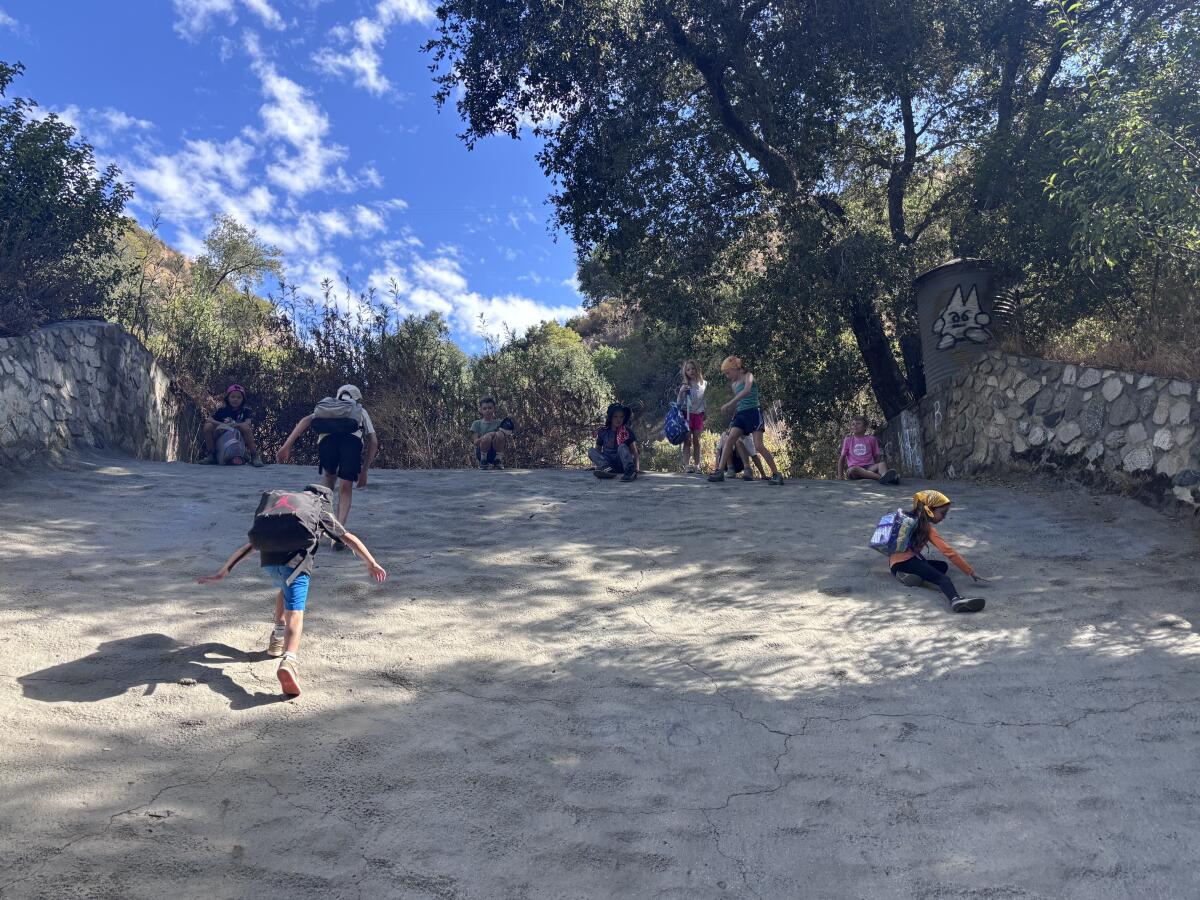I thought I’d noticed everything on the four-mile stretch of the Gabrielino Trail from its western trailhead near Pasadena to the Gould Mesa campground in Angeles National Forest.
I have a favorite sycamore tree about a mile in that, if it weren’t surrounded by poison oak, I would climb. I know some of the best water spots to splash around in the Arroyo Seco. I know how to identify and spot sacred datura, a common sight along the path.
But then I hiked the trail with a group of children (and a handful of grown-ups) from the L.A.-based adventure club Hiking Adventures With Kids (or HAWKs for short) and was reconnected with the childhood sense of wonder that our day-to-day adult lives grind down.
I saw the trail through the eyes of tweens who love nature so much, they screamed multiple facts at me, often all at once, including how cool vampire squid are, that rolly-pollies are related to crabs and that my skin was actively dying and falling off my body. It was such a comfort.
Here’s what I learned from my new trail buddies. I hope these tips help remind you to slow down and appreciate the wonders of our local flora and fauna.
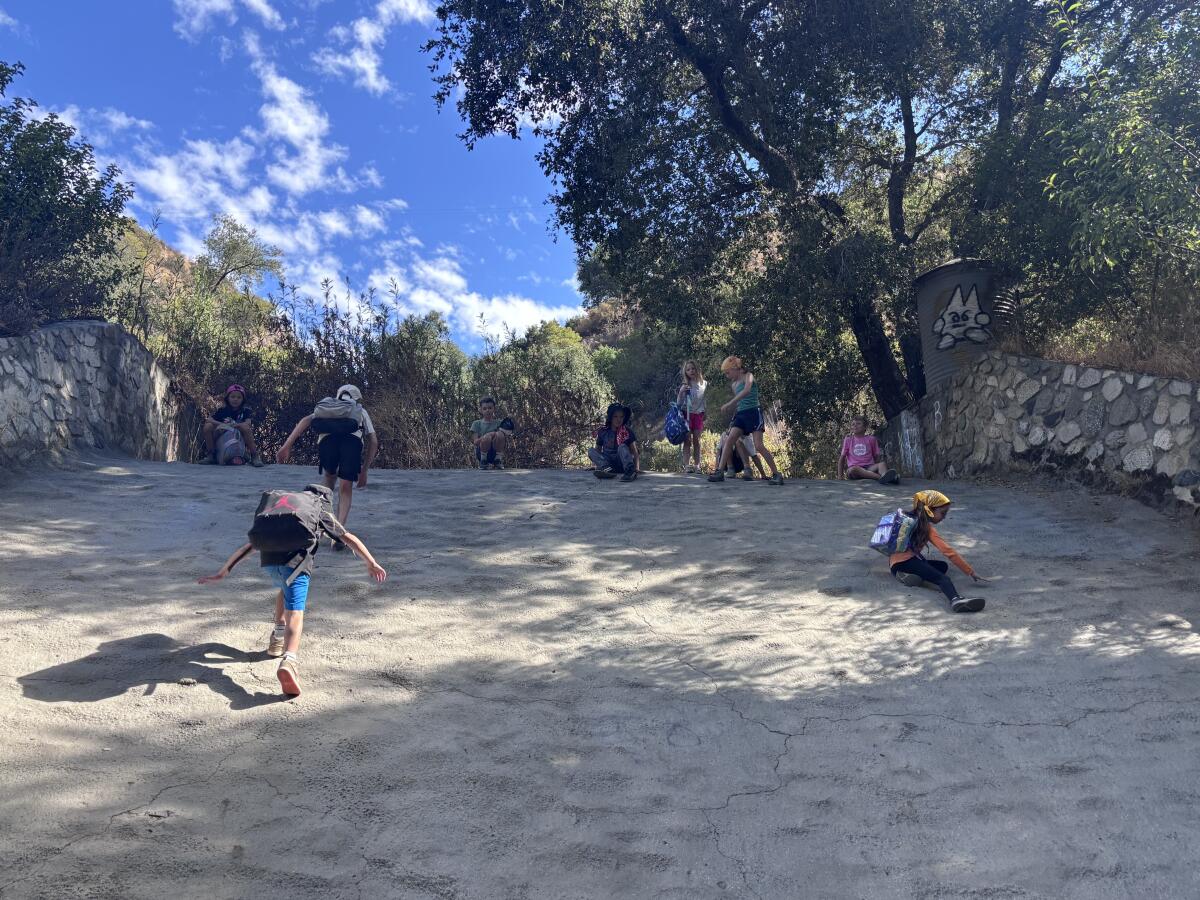
Children from a HAWKs group slide down a concrete channel just off the Gabrielino Trail near Pasadena.
(Jaclyn Cosgrove / Los Angeles Times)
1. A group of canines being walked on the trail by a human is a ‘dog parade.’
Wave accordingly.
2. If you see poison oak, tell a friend.
These kids saved me multiple times from brushing up against the woody shrub. They reminded me: “Leaves of three, let it be; if it’s hairy, it’s a berry!”
3. Eggnog.
This is less of a tip and more of an inside joke between best friends Lila and Elliot, both 10, who asked really nicely for me to include it. May they forever remember the time one of the largest newspapers in America published this.
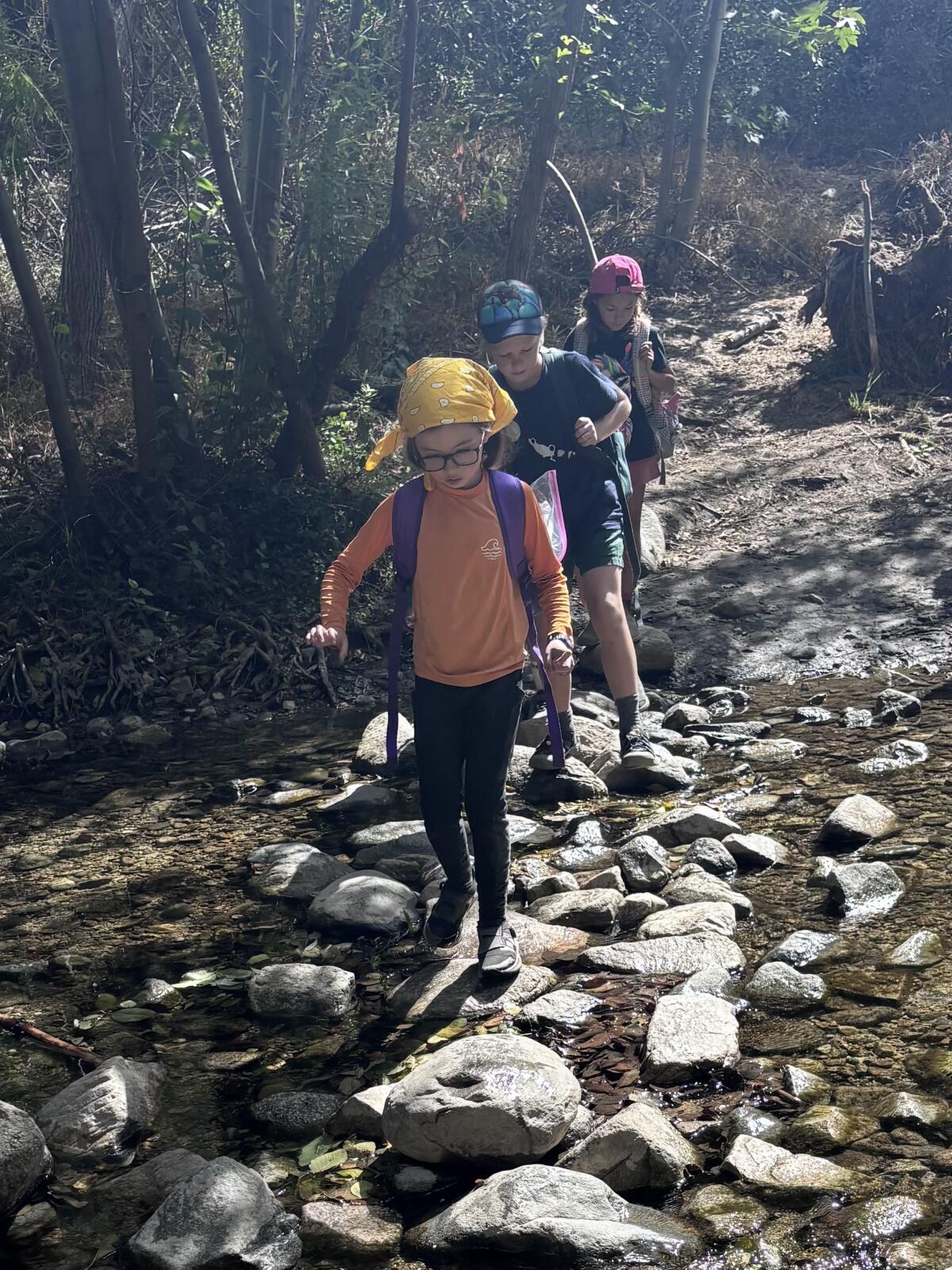
Children from HAWKs, an L.A.-based company that takes kids on outdoors adventures, cross the Arroyo Seco near Pasadena.
(Jaclyn Cosgrove / Los Angeles Times)
4. Put animals down that don’t want to be touched.
Bradley Rydholm, a HAWKs educator co-leading the day’s hike, found a diabolical ironclad beetle to show the kids. It was at first playing dead, and some of the children reached out to touch it.
“You need to put him down because he looks like he doesn’t want to be touched,” Kaija, 8, said. “If they’re moving in your hand, that means it’s OK, but if they’re playing dead, you gotta put them back.”
Rydholm gently agreed and placed the beetle back in its pile of dirt and leaves.
5. When naming bugs, consider a compromise.
OK, perhaps this is a lesson the kids learned from me. The group was in a debate over whether to name the aforementioned diabolical ironclad beetle, with some voting for “Desi” and others voting for “Jim.”
This reporter, in the name of peace, suggested Desi Jim. “Bye, Desi Jim!” they called in unison as we continued onward.
6. Follow the ethics of frog catching.
Kaija, who asked whether I could make her a wolf in my story, told me that it’s best to catch frogs, name them and then release them.
I asked her whether she had any tips for naming frogs. “Jeremy, Fred, Pineapple,” she said, adding that she names them by their color.
I wanted to learn what color Jeremy was, but she discovered something far more interesting than me on the trail and ran off.
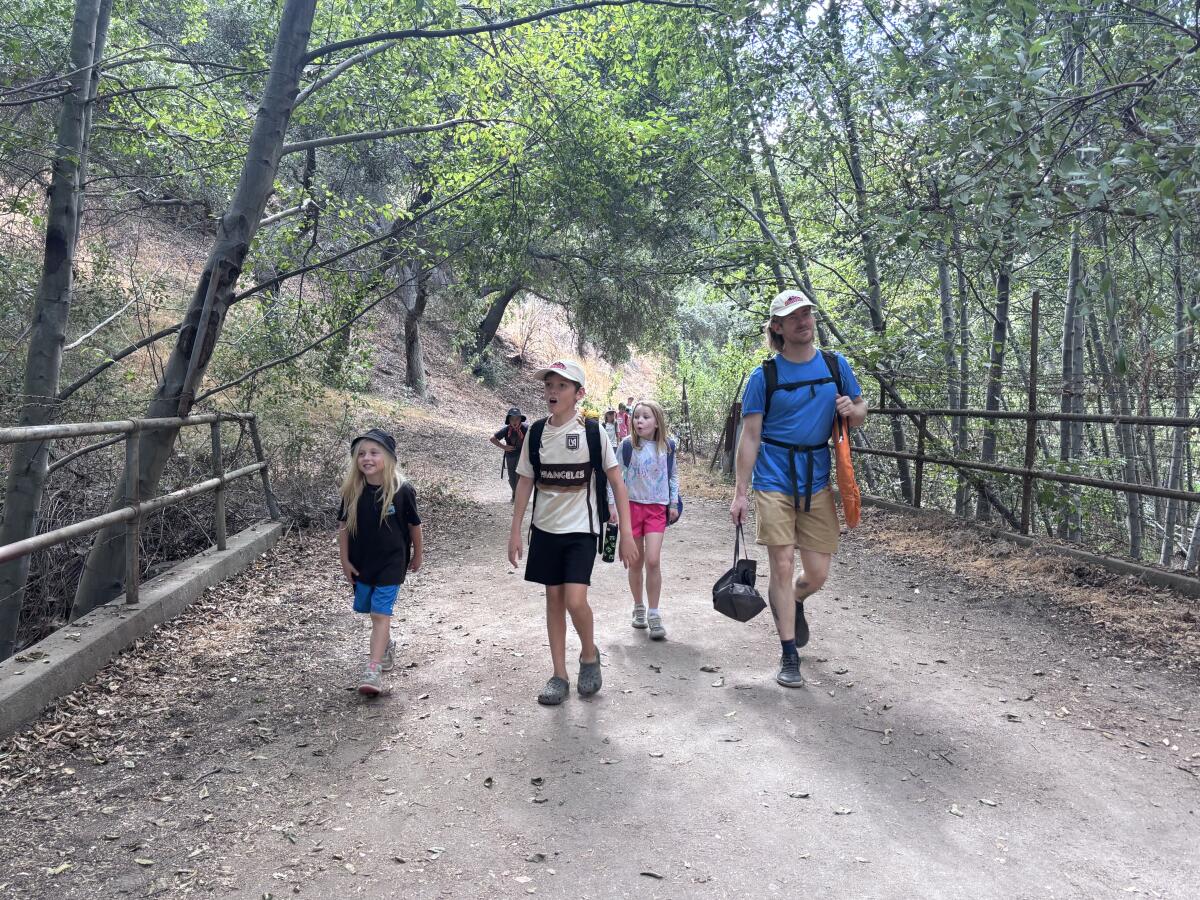
HAWKs hike leader Bradley Rydholm leads children down the Gabrielino Trail near Pasadena.
(Jaclyn Cosgrove / Los Angeles Times)
7. If you want to touch a bug, take a picture first.
Ella, 8, told me that after you take a picture of the insect, you can use a smartphone to identify it and figure out whether it is venomous. (Note: Unlike plenty of adults, she knew the difference between “poisonous” and “venomous” and used the words correctly!)
“If it isn’t [venomous] and it’s totally safe, I would probably bring gloves because I’m scared of picking up bugs,” Ella said. “One time a lady bug peed on me.”
8. It is important to have a compass.
“Because if you get lost, it’s not very efficient to always rely on the North Star. Because it’s only around for a little bit [of] time. So if you don’t have a compass and you get lost, you’re going to have to wait until night to be able to move,” said Luca, 9, who bought himself a compass in a local shop in Felton.
Luca and I swapped adventure stories, as he is quite the world traveler. As a bonus tip, he informed me that it’s easier to roast marshmallows on a volcano (he visited one in Guatemala) than over a campfire. The volcano’s heat slow roasts the marshmallows; with a campfire, you’re more likely to accidentally light them on fire.
9. Avoid hills.
A few of the kids recently went on a HAWKs hike that apparently involved a “death road” that felt like “the stairwell of a million stairs” that went “pretty much nowhere” and had no real views, per Luca’s description.
Elliot, when asked for tips that adults should consider while hiking, told me that she enjoys being outside, but “I don’t really like going uphill.”
Same, girl. Same.
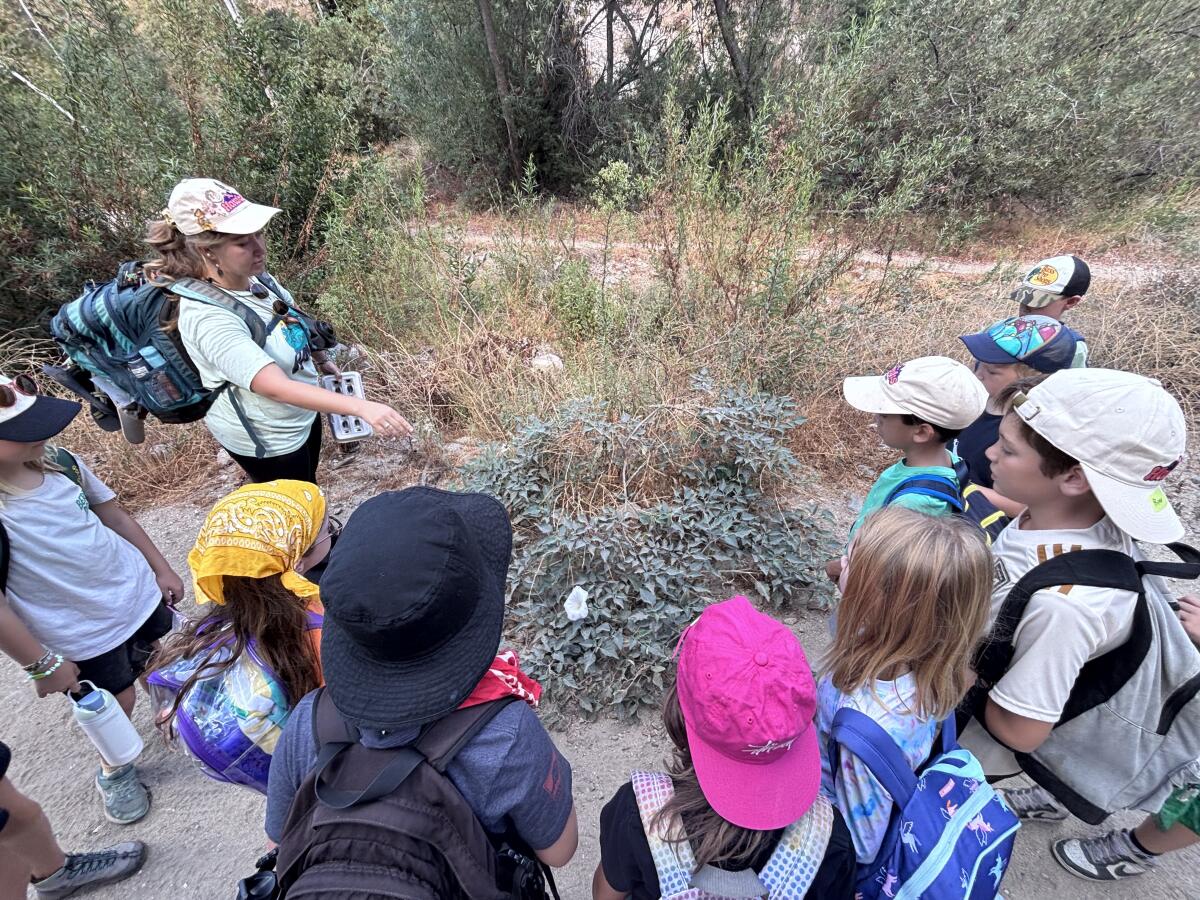
Kelly Knowles, a HAWKs educator, explains to the group the cultural significance of sacred datura to local Indigenous peoples.
(Jaclyn Cosgrove / Los Angeles Times)
10. Appreciate the beauty of nature.
“I really like water,” Luca said. “Just enjoy the sound of water and just enjoy the nature, and check out the animals, lizards, snakes, butterflies and moths.”
“It’s really beautiful to see all these paths,” Lila said. “The beauty of nature is so fun, and it’s a good way to get a workout in or just get off screens because kids these days are on screens a lot. Brain rot!”
“I just remember it’s really good for me,” Elliot said. “The same thing about screens too, even though I don’t have an iPad since my brother broke it. … Honestly, I don’t want to think about anything from school or anything. Just want to be in the moment, ya know?”

3 things to do
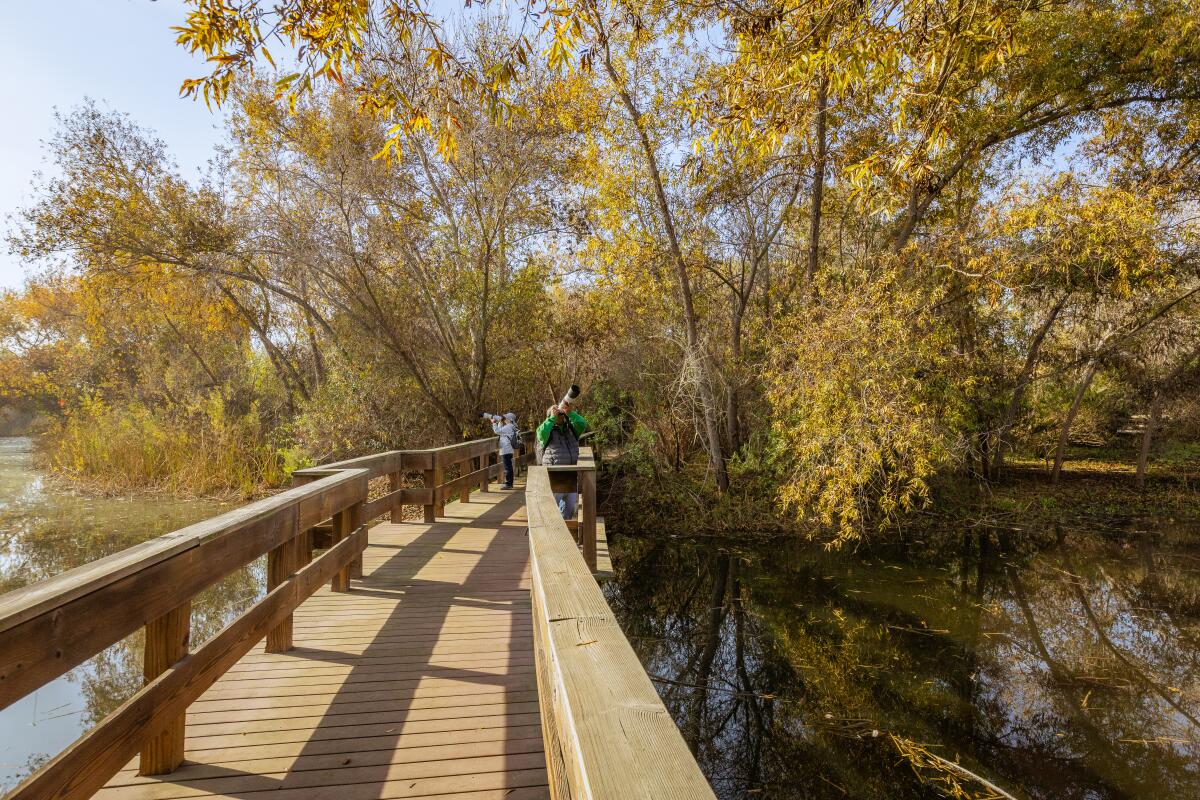
The Bixby Marshland, a 17-acre marsh, is located to the northwest of the A.K. Warren Water Resource Plant (formerly the Joint Water Pollution Control Plant) near the intersection of Figueroa Street and Sepulveda Boulevard in Carson.
(Los Angeles County Sanitation Districts)
1. Explore a marsh in Carson
The Los Angeles County Sanitation Districts will host a tour from 8 a.m. to noon of the Bixby Marshlands, a 17-acre marsh near the intersection of Figueroa Street and Sepulveda Boulevard in Carson. Formerly part of a large freshwater marshland area called Bixby Slough, the Bixby Marshland was cut off from its water supply when the Wilmington Drain was installed in the mid-1970s, according to the agency. Docents will be at the event to help visitors spot the dozens of ducks, herons, hummingbirds and many other animals that frequent the marsh. Learn more at lacsd.org.
2. Yank weeds in Chino Hills
Volunteers are needed from 9 a.m. to noon Saturday at Chino Hills State Park to help restore a walnut woodland. Participants will pull and dig up invasive weeds, bagging and removing them from the area. The exact location of the volunteer opportunity and directions will be emailed upon registration. Sign up at volunteer.calparks.org.
3. Can’t fight the moonlight in Burbank
The Stough Canyon Nature Center in Burbank will host a full moon hike at 7 p.m. Monday. Hikers will meet at the Stough Canyon trailhead. This is a free all-ages hike. Children younger than age 12 must be accompanied by an adult. Register using the “Stough Canyon Nature Center” tab at burbankparks.com.

The must-read
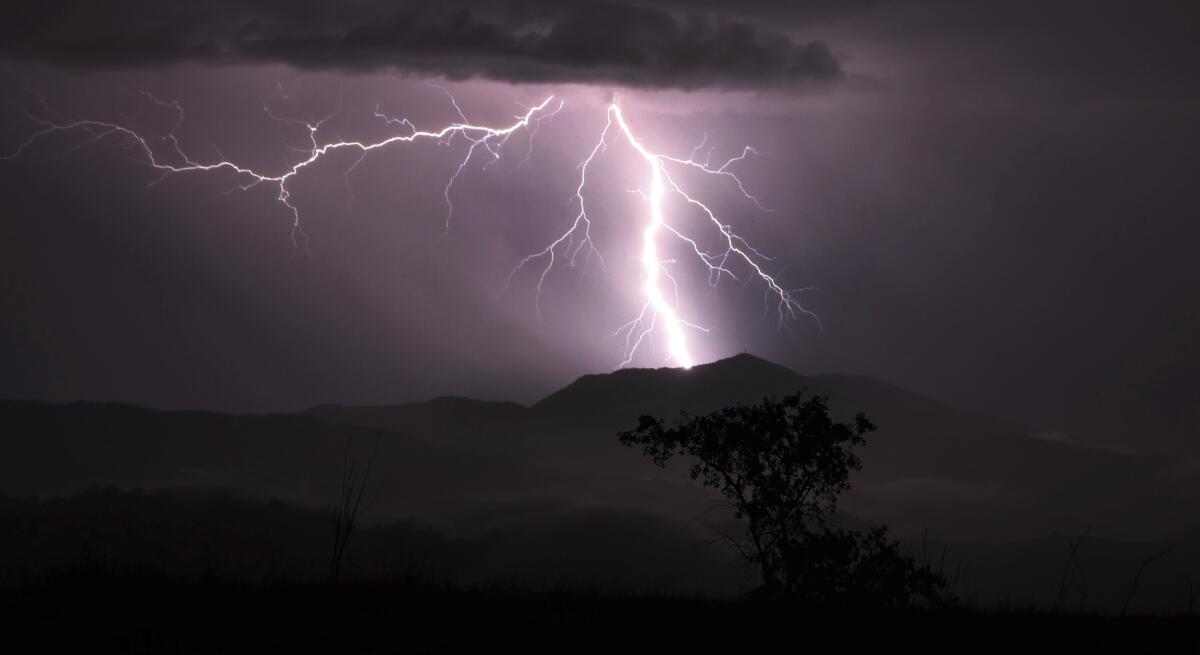
Lightning strikes over Mt. St. Helena in Napa County.
(Kent Porter / AP)
Even with months of training and prep work, Megan Eskew did not stay long at the Mt. Whitney summit. There was a chance of thunderstorms in the area. Eskew was on her way down when she felt the first sprinkle. “Before you could even process the thought, ‘Oh, that’s rain,’ thunder boomed,” Eskew said. Times staff writer Jack Dolan wrote about the dangers that hikers faced as late-summer monsoons spread across California in recent weeks. Jack also covered the perils of trying to hide from the storm — and the importance of knowing when to turn around. Stay safe out there!
Happy adventuring,

P.S.
I love looking for signs of our local mammal population on trails. In a recent Instagram post, So Sinopoulos-Lloyd, co-founder of Queer Nature, explained how to identify mountain lion markings left on a tree, including how to distinguish between scratches left by a big cat versus a bear. The grooves left in the tree reminded me of the marks that my cats leave on their scratching posts (and other less-than-ideal places around our home!). Let me know if you notice similar out on the trails.
For more insider tips on Southern California’s beaches, trails and parks, check out past editions of The Wild. And to view this newsletter in your browser, click here.
